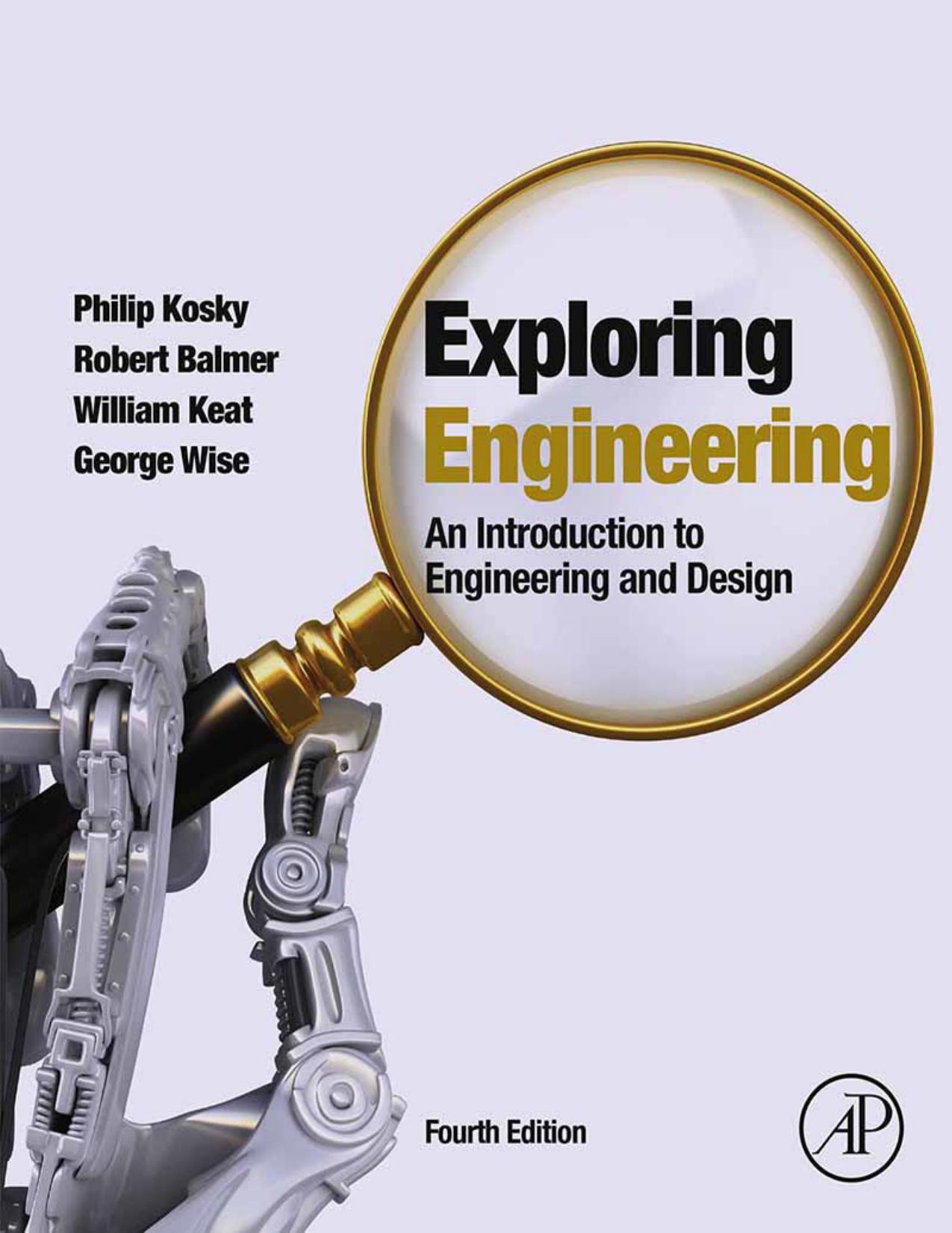Exploring Engineering An Introduction to Engineering and Design 4th Edition by Robert Balmer 9780128025888 0128025883
$70.00 Original price was: $70.00.$35.00Current price is: $35.00.
Instant download Exploring Engineering An Introduction to Engineering and Design after payment
Exploring Engineering An Introduction to Engineering and Design 4th Edition by Robert Balmer- Ebook PDF Instant Download/Delivery: 9780128025888, 0128025883
Full dowload Exploring Engineering An Introduction to Engineering and Design 4th Edition after payment

Product details:
• ISBN 10:0128025883
• ISBN 13:978012802588
• Author:Robert Balmer
Exploring Engineering: An Introduction to Engineering and Design
Exploring Engineering, Fourth Edition: An Introduction to Engineering and Design presents the emerging challenges engineers face in a wide range of areas as they work to help improve our quality of life. In this classic textbook, the authors explain what engineers actually do, from the fundamental principles that form the basis of their work to the application of that knowledge within a structured design process. The text itself is organized into three parts: Lead-On, Minds-On, Hands-On. This organization allows the authors to give a basic introduction to engineering methods, then show the application of these principles and methods, and finally present a design challenge. This book is an ideal introduction for anyone interested in exploring the various fields of engineering and learning how engineers work to solve problems.NEW: Chapters on Aeronautical Engineering, Industrial Engineering, and Design TeamsNEW: Expanded content in the chapters “Defining the Problem,” “Generation of ‘Alternative Concepts’,” and “Detailed Design”NEW: Material on sustainability issues in engineeringIntroduces students to the engineering profession, emphasizing the fundamental physical, chemical, and material bases for all engineering workIncludes an Engineering Ethics Decision Matrix used throughout the book to pose ethical challenges and explore decision-making in an engineering contextLists of “Top Engineering Achievements” and “Top Engineering Challenges” help put the material in context and show engineering as a vibrant discipline involved in solving societal problems
Exploring Engineering An Introduction to Engineering and Design 4th Table of contents:
Part 1: Lead-On
Introduction
Chapter 1: What Engineers Do
Abstract
1.1 Introduction
1.2 What is Engineering?
1.3 What Do Engineers Do?
1.4 Where Do Engineers Work?
1.5 What is Engineering Technology?
1.6 What Makes a “Good” Engineer?
1.7 What This Book Covers
1.8 Personal and Professional Ethics
1.9 What Are Professional Ethics?
1.10 Engineering Ethics Decision Matrix
1.11 What Should You Expect From This Book?
Summary
Exercises
Final Thoughts
Chapter 2: Elements of Engineering Analysis
Abstract
2.1 Introduction
2.2 Engineering Drawing and Sketching
2.3 Engineering Variables
2.4 Engineering Units of Measurement
2.5 Significant Figures
2.6 The “Need-Know-How-Solve” Method
2.7 Spreadsheet Analysis
Summary
Exercises
Chapter 3: Force and Motion
Abstract
3.1 Introduction
3.2 What is a Force?
3.3 Newton’s First Law
3.4 Newton’s Second Law
3.5 Newton’s Third Law
3.6 Free-Body Diagrams
3.7 What is Kinematics?
3.8 The Equations of One-Dimensional Kinematics
Summary
Exercises
Chapter 4: Energy
Abstract
4.1 Introduction
4.2 Energy is the Ability to do Work
4.3 Kinds of Energy
4.4 Energy Conversion
4.5 Conservation of Energy
Summary
Exercises
Chapter 5: Engineering Economics
Abstract
5.1 Introduction
5.2 Why is Economics Important?
5.3 The Cost of Money
5.4 When is an Investment Worth it?
Summary
Exercises
Part 2: Minds-On
Introduction
Chapter 6: Aeronautical Engineering
Abstract
6.1 Introduction
6.2 Airfoils and Lift
6.3 The Algebra of Imaginary Numbers
6.4 Conformal Mapping
6.5 The Joukowski Airfoil Theory
6.6 The Kutta Condition
6.7 Symmetric Airfoils
6.8 Major Factors in Aircraft Economy
Summary
Exercises
Chapter 7: Chemical Engineering
Abstract
7.1 Introduction
7.2 Chemical Energy Conversion
7.3 Atoms, Molecules, and Chemical Reactions
7.4 The mol and the kmol
7.5 Stoichiometry
7.6 The Heating Value of Hydrocarbon Fuels
7.7 Chemical Engineering: How Do You Make Chemical Fuels?
7.8 Modern Chemical Engineering
Summary
Exercises
Chapter 8: Civil Engineering
Abstract
8.1 Introduction
8.2 What Do Civil Engineers Do?
8.3 Structural Engineering
8.4 Geotechnical Engineering
8.5 Water Resources Engineering
Summary
Exercises
Chapter 9: Computer Engineering
Abstract
9.1 Introduction
9.2 Moore’s Law
9.3 Analog Computers
9.4 From Analog to Digital Computing
9.5 Binary Logic
9.6 Truth Tables
9.7 Decimal and Binary Numbers
9.8 Binary Arithmetic
9.9 Binary Codes
9.10 How Does a Computer Work?
Summary
Exercises
Chapter 10: Electrical Engineering
Abstract
10.1 Introduction
10.2 Electrical Circuits
10.3 Resistance, Ohm’s Law, and the “Power Law”
10.4 Series and Parallel Circuits
10.5 Kirchhoff’s Laws
10.6 Switches
Summary
Exercises
Chapter 11: Industrial Engineering
Abstract
11.1 Introduction
11.2 Manufacturing and Quality Control
11.3 Methods Engineering
11.4 Simulation Analysis and Operation Research
11.5 Ergonomics
11.6 Material Handling
Summary
Exercises
Chapter 12: Manufacturing Engineering
Abstract
12.1 Introduction
12.2 What Is Manufacturing?
12.3 Early Manufacturing
12.4 Industrial Revolution
12.5 Manufacturing Processes
12.6 Modern Manufacturing
12.7 Variability and Six Sigma
Summary
Exercises
Chapter 13: Materials Engineering
Abstract
13.1 Introduction
13.2 Choosing the Right Material
13.3 Strength
13.4 Defining Materials Requirements
13.5 Materials Selection
13.6 Properties of Modern Materials
Summary
Exercises
Chapter 14: Mechanical Engineering
Abstract
14.1 Introduction
14.2 Mechanical Engineering
14.3 The Elements of Thermal Design
14.4 The Elements of Machine Design
Summary
Exercises
Chapter 15: Nuclear Engineering
Abstract
15.1 Introduction
15.2 Nuclear Power Reactors
15.3 Neutron Moderation
15.4 How Does a Nuclear Reactor Work?
15.5 The Four Factor Formula
15.6 Fission Products and Nuclear Waste
15.7 Is Nuclear Power a Viable Renewable Energy Source?
Summary
Exercises
Part 2.1: Emerging Engineering Fields
Introduction
Chapter 16: Bioengineering
Abstract
16.1 Introduction
16.2 What Do Bioengineers Do?
16.3 Biological Implications of Injuries to the Head
16.4 Why Collisions Can Kill
16.5 The Fracture Criterion
16.6 The SSSA Criterion
16.7 Criteria for Predicting Effects of Potential Accidents
Summary
Exercises
Chapter 17: Electrochemical Engineering
Abstract
17.1 Introduction
17.2 Electrochemistry
17.3 Principles of Electrochemical Engineering
17.4 Lead-Acid Batteries
17.5 The Ragone Chart
17.6 Electrochemical Series
17.7 Advanced Batteries
17.8 Fuel Cells
17.9 Ultracapacitors
Summary
Exercises
Chapter 18: Green Energy Engineering
Abstract
18.1 Introduction
18.2 Solar Energy
18.3 Other Green Energy Sources
18.4 Sustainable Engineering
Summary
Exercises
Part 3: Hands-On
Introduction
Chapter 19: Introduction to Engineering Design
Abstract
19.1 Introduction
19.2 The Nature of Engineering Design
19.3 Design Problems vs. Homework Problems
19.4 Benefits of a Hands-On Design Project
19.5 Qualities of a Good Designer
19.6 Using a Design Notebook
19.7 The Need for a Systematic Approach
19.8 Steps in the Engineering Design Process
19.9 Hands-On Design Exercise: “The Tower”
Exercises
Chapter 20: Design teams
Abstract
20.1 Introduction
20.2 How to Manage a Design Team Project
20.3 Effective Teaming
Exercises
Chapter 21: Design Step 1: Defining the Problem
Abstract
21.1 Introduction
21.2 Identifying the Need
21.3 Defining the Problem
21.4 List of Design Specifications
21.5 Clarifying the Problem
21.6 Design Milestone: Clarification of the Task
Exercises
Chapter 22: Design Step 2: Generation of Alternative Concepts
Abstract
22.1 Introduction
22.2 Brainstorming
22.3 Concept Sketching
22.4 Hands-on Design Exercise: “The Tube”
22.5 Research-Based Strategies for Promoting Creativity
22.6 Functional Decomposition for Complex Systems
22.7 Design Milestone: Generation of Alternatives
Exercises
Chapter 23: Design Step 3: Evaluation of Alternatives and Selection of a Concept
Abstract
23.1 Introduction
23.2 Minimize the Information Content of the Design
23.3 Maintain the Independence of Functional Requirements
23.4 Design for Ease of Manufacture
23.5 Design for Robustness
23.6 Design for Adjustability
23.7 Hands-On Design Exercise: “Waste Ball”
23.8 The Decision Matrix
23.9 Design Milestone: Evaluation of Alternatives
Exercises
Chapter 24: Design Step 4: Detailed Design
Abstract
24.1 Introduction
24.2 Analysis
24.3 Mechanism Control
24.4 Experiments
24.5 Models
24.6 Detailed Drawings
24.7 Design Milestone: Detailed Design
Exercises
Chapter 25: Design Step 5: Design Defense
Abstract
25.1 Introduction
25.2 How to Prepare an Oral Defense
25.3 Design Milestone: Oral Design Defense
Exercises
Chapter 26: Design Step 6: Manufacturing and Testing
Abstract
26.1 Introduction
26.2 Manufacturing and Testing Strategies
26.3 Materials
26.4 Joining Methods
26.5 Useful Hand Tools
26.6 Design Milestone: Design for Manufacture – Assessment I
26.7 Design Milestone: Design for Manufacture – Assessment II
Exercises
Chapter 27: Design Step 7: Performance Evaluation
Abstract
27.1 Introduction
27.2 Individual Performance Testing
27.3 The Final Competition
27.4 Design Milestone: Individual Performance Testing
Exercises
Chapter 28: Design Step 8: Design Report
Abstract
28.1 Introduction
28.2 Organization of the Report
28.3 Writing Guidelines
28.4 Technical Writing is “Impersonal”
28.5 Design Milestone: Design Report
Exercises
Chapter 29: Examples of Design Competitions
Abstract
29.1 Introduction
29.2 Design Competition Example 1: A Bridge Too Far
29.3 Design Milestone Solutions for “A Bridge Too Far”
29.4 Official Rules for the “A Bridge Too Far” Design Competition
29.5 Design Competition Example 2: Mars Meteorite Retriever Challenge
29.6 Some Design Milestones for the “Mars Meteorite Retriever Challenge”
29.7 Official Rules for the “Mars Meteorite Retriever Challenge” Design Competition
Exercises
Chapter 30: Closing Remarks on the Important Role of Design Projects
Abstract
Index
People also search for Exploring Engineering An Introduction to Engineering and Design 4th:
exploring engineering
exploring engineering 5th edition pdf
exploring engineering at purdue
exploring engineering studies uf
exploring engineering careers


